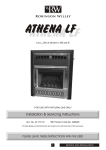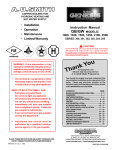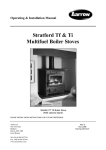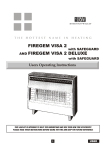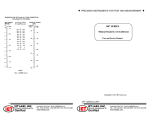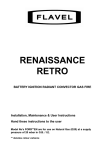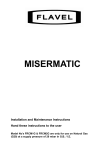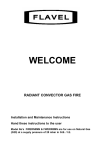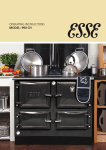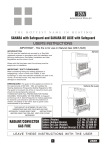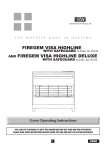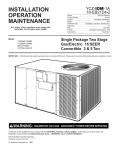Download Robinson Willey SuperEco Desire Technical data
Transcript
Robinson Willey D269 Handbook Contemporary, Charisma, Classic (BRASS OR CHROME with COAL EFFECT) Desire ( STAINLESS STEEL with PEBBLE EFFECT ) Cat I2H G20 at 20mbar For use in GB and IE. The data plate is located at the bottom left hand side of the firebox This handbook contains both Installer and user information and must be left with the owner. CONTENTS SECTION PAGE INSTALLATION SECTION INTRODUCTION AND GENERAL REQUIREMENTS TECHNICAL DATA CONTENTS OF SCREW PACK CONTENTS OF CERAMIC FUEL COMPONENT PACK CONDITIONS OF INSTALLATION SITING GENERAL FLUES AND CHIMNEYS Brick Chimney, 178mm diameter (7 inch) Stone or Lined Flue and 125mm diameter (5 inch) Flue Pre-Cast Flue Rebated Surround Installation Metal Fluebox 125mm diameter (5 inch) Flues SHELF HEIGHT AND SIDE CLEARANCES INSTALLATION OF FIRE UNPACKING PREPARATION OF FIRE Spigot Restrictor Fender Mask Burner Tray (manual) Burner Tray (slider) METHODS OF INSTALLATION Fixing by Tension Cable Fixing Directly to Surround Face GAS CONNECTION Concealed Connection TEST FOR GAS SOUNDNESS COMMISSIONING INSTALL FUEL EFFECT COMPONENTS CHECK GAS PRESSURE/FIT TRIM AND ASHPAN TEST FOR SPILLAGE CHECK IGNITION CHECK OPERATION OF FSD INSTRUCT USER SERVICING INSTRUCTIONS REMOVE BURNER TRAY MAIN BURNER INJECTOR GAS TAP ASSEMBLY PILOT ASSEMBLY FUEL EFFECT COMPONENTS MAIN BURNER CONTROL KNOB HINTS ON FAULT FINDING 1.0 2.0 3.0 4.0 5.0 5.1 5.2 3 3 4 4 5 5 5 5.2.1 5.2.2 5.2.3 5.2.4 5.3 6.0 6.1 6.2 6.2.1 6.2.2 6.2.3 6.2.4 6.3 6.3.1 6.3.2 6.4 6.4.1 6.5 7.0 7.1 7.2 7.3 7.4 7.5 8.0 9.0 9.1 9.2 9.3 9.4 9.5 9.6 9.7 10.0 5 6 7 8 9 9 9 9 9 10 10 10 11 11 11 12 12 12 13 13 14 14 14 14 15 15 15 15 15 16 16 16 16 17 11.0 11.1 12.0 13.0 13.1 13.2 13.3 14.0 14.1 14.2 14.3 14.4 15.0 15.1 18 18 19 20 20 20 20 21 22 22 23 24 24 24 USER SECTION USER INFORMATION SHELF HEIGHT AND SIDE CLEARANCES CLEANING AND MAINTENANCE OPERATING INFORMATION MANUAL CONTROL VERSION SLIDER CONTROL VERSION REPLACING THE BATTERY (DESIRE) FUEL EFFECT COMPONENTS PLACEMENT-ALL PEBBLE LAYOUT LIGHTING WITH TAPER-PEBBLE FIRE COAL LAYOUT LIGHTING WITH TAPER-COAL FIRE SPARES AND SERVICES PARTS REPLACEABLE BY USER 2 1.0 INTRODUCTION NO COMPONENT OF THIS FIRE IS MANUFACTURED FROM ASBESTOS OR ASBESTOS RELATED PRODUCTS. This appliance is an open fronted inset live fuel effect gas fire, it is suitable for use with Brick Chimneys(including lined), twin walled or insulated Metal/Pre-fabricated Flues of 125mm minimum diameter and Flueboxes conforming to the constructional requirements of BS 715 and Pre-Cast Flue applications. It is fitted with a combined flame supervision and oxygen depletion monitoring device. The fire is for hearth mounting only on a non-combustible hearth. If required the fire can be fitted using a 152mm (6”) rebated surround if it is to be installed in a pre-cast flue (optional extras are required). 1.1 GENERAL INSTALLATION REQUIREMENTS In your own interest and that of safety, it is the law that all gas appliances are installed by competent persons in accordance with the current Gas Safety (Installation and Use) Regulations. Failure to install appliances correctly could lead to prosecution. The installation MUST be in accordance with these installation instructions, all the relevant parts of the Local and National Building Regulations or Building Standards (Scotland) (Consolidation) Regulations and the relevant recommendations of the current editions of the following British Standards: B.S. 5871 : Part 2 B.S. 5440 : Parts 1 and 2 B.S. 6891 B.S. 6461 : Parts 1 and 2 B.S. 1289 : Part 2 B.S. 715 B.S. 1251 B.S. 1289 B.S. 1289 : Part 1 Any other relevant British Standard Code of Practice and/or Local Building Regulations and in accordance with the rules in force. This appliance must be installed in accordance with the rules in force, and used only in a sufficiently ventilated space. Consult instructions before installation and use of this appliance. 2.0 TECHNICAL DATA D269 - SuperEco range of I.L.F.E. Gas Fires (Contemporary, Charisma, Classic & Desire). The efficiency of this appliance has been measured as specified in BS 7977-1:2002 and the result is 61.5%. The gross calorific value of the fuel has been used for this efficiency calculation. The test data from which it has been calculated has been certified by Notified Body No. 0087. The efficiency value may be used in the UK Government's Standard Assessment Procedure (SAP) for energy rating of dwellings. The above exceeds the minimum requirement of 45%. 1.1 DIMENSIONS (Contemporary, Charisma, Classic & Desire) (Overall) mm Height 595 Width 500 Depth 140 Forward Projection 90 (Desire 65) Height to top of flue aperture 504 1.2 INPUTS AND PRESSURES Natural Gas Maximum Heat Input Maximum Heat Output Efficiency Class Supply Pressure Setting Pressure 6.5 kW (GROSS) 22178 Btu/h 4.0 kW 13648 Btu/h II 20.0 mbar 8.0 in wg 16.8 mbar ( ± 1 mbar) 6.5”w.g ( ± 0.4 in wg) 1.3 BURNER AND CONTROL DETAILS Main Burner Pilot Burner Injector (Main Burner) Spark Gap Manual Control Slider Control Battery (Slider option) SP988930 SP822468 SP822469 3.0mm to 5.0mm SP822395 SP822596 9V PP3 3 3.0 CONTENTS OF SCREW PACK Fig. 1. The contents of the screw pack are as follows (refer to Fig 1.): Key Qty Description A B C D E F G H J 2 2 2 4 4 4 4 1 2 Fixing Cables Cable Adaptors Grub Screws Cable Eyelets Wall Plugs Fire Fixing Screws No 6 Self Tapping Screws Gas Inlet Grommet Cable Tensioning Bolts K 2 No. 8 Self Tapping Screws (not illustrated) J H A E I G C B D F NOTE: Also included in the pack is the ‘Spacer’ required to fit the fire to some pre-cast flues - see section 5.2.2 page 6. The two screws - item K above - may be required. 4.0 CONTENTS OF CERAMIC FUEL COMPONENT PACK The contents of the ‘pebble’ set are as follows(see fig 2a) : - The contents of the coal set are as follows (see to Fig 2b.): - Key Qty Description Key Qty Description I II III IV V VI 1 1 1 1 17 1 Base Ceramic Matrix Centre Ceramic Left Hand Side Cheek Right Hand Side Cheek Pebbles (see photograph) Back brick panel (Supplied fitted in fire) I II III IV V VI VII 1 1 1 1 4 14 1 Base Ceramic Matrix Centre Ceramic Left Hand Side Cheek Right Hand Side Cheek Front Coals Standard Coals Back brick panel (Supplied fitted in fire) Fig. 2a II Fig. 2b I I II VI III IV V VII V VI 4 III IV 5.0 CONDITIONS OF INSTALLATION 5.1 SITING GENERAL This fire is suitable for hearth mounting only on a non-combustible hearth at least 13mm thick and measuring at least 630mm wide by 330mm deep, the periphery of which should preferably be 50mm above the floor level in order to discourage the placing of carpets or rugs over it. It MUST NOT be fitted directly on a combustible wall. The fire should be installed so that no part of a combustible wall i.e. not part of the fire surround but a full wall at 90o to the fire is less than 500mm from the radiant source. If this is not possible the combustible side wall must be suitably protected. FIREPLACE OPENING The front opening of the fireplace must be between 406mm and 457mm wide and between 550mm and 572mm high (see Section 5.2). If the opening is greater it must be bricked up until the opening is a maximum of 572mm high and 457mm wide, alternatively a noncombustible infill panel may be used to achieve the required dimensions. DO NOT USE THE BACK OF A FIRE SURROUND OR MARBLE TO ACHIEVE THE ABOVE DIMENSIONS. There must be a minimum flat surface area around the fireplace opening shown by the dotted lines in Fig. 4 to ensure a good seal between the fireplace and the fire. This area should be sound enough to take the wall plugs and screws supplied for front fixing. Ensure that the base of the fireplace is level with the hearth and reasonably flat to prevent the fire rocking. Purpose built ventilation bricks or additional air vents are not normally required in the room in which the fire is fitted unless specified by the rules in force. IMPORTANT: When fitting any heating appliance or wallpapering a room in which one is fitted, soft wall coverings such as heat sensitive wallpapers may become heat damaged or discoloured especially in the area above the fire. Please bear this in mind when installing or decorating. FIRE SURROUND: The fire is suitable for purpose-made proprietary hearths/surrounds with temperature rating of 150oC. 5.2 FLUES AND CHIMNEYS 5.2.1 SITE REQUIREMENTS FOR 228mm BY 228mm (9in BY 9in) BRICK CHIMNEY/178mm (7in) STONE OR LINED CHIMNEY AND 125MM (5in) DIAMETER FLUE The minimum dimensions for the fireplace opening for a brick chimney are as shown in Fig. 3. It will not normally be necessary to remove any chair brick provided the minimum depth is obtained. A chimney previously used to burn solid fuel must be swept prior to installation. The chimney must be inspected to ensure that: (a) It serves only one fireplace. (b) It is properly sealed so that combustion products do not escape from the flue into the room. (c) It is not blocked by paper, rubble etc. (d) Any restriction such as damper, register plate, etc. must be removed or secured in the fully open position. (e) Any underdraught ventilation or additional air supply entering the fireplace or on the hearth must be sealed off. (f) It must have at least 3 metre effective flue height. (g) It must have a positive updraught. IN 505 mm M CHECK THE FLUE FOR GOOD DRAUGHT Apply a lighted paper or smoke match to the top of the opening in the fireplace. Observe if there is a definite flow into the chimney and if so proceed with fitting the fire. If no flow is indicated, warm the chimney for several minutes and then re-check. If downdraught is observed a suitable terminal must be fitted and the chimney re-checked. If persistent no-flow or downdraught condition is observed 550 mm MIN 572 mm MAX 610 mm MIN DO NOT FIT THE FIRE, SEEK EXPERT ADVICE. 165 mm MIN MIN 406 mm MAX m 457 m 5 Fig. 3 5.2.2 PRE-CAST FLUE OF MINIMUM SIZE (Fig. 4) PRE-CAST FLUE INSTALLATION This fire can be installed into a properly constructed pre-cast flue conforming to B.S. 1289 : 1975 or B.S. 1289 : Part 1 : 1986 or B.S. 1289 : Part 2 : 1989 of at least 3 metres effective height and having flueways of at least 198mm by 67mm or equivalent cross-sectional area with no dimension less than 63mm. The fireplace opening width must be between a maximum 457mm and a minimum 406mm. The fireplace opening height must be between a maximum of 572mm and a minimum 550mm and a depth of at least 120mm above the hearth level. Fig. 4 NOTES: 1. The minimum dimensions for the flat area around the opening are 610 mm high x 505mm wide. 2. The flue spigot restrictor MUST NOT be fitted. Ensure that any mortar fangs between the blocks do not protrude into the flueways and if raking blocks are used they are fitted according to the manufacturers instructions and mortar is not allowed to drop down and accumulate in the raked portions. CHECK THE FLUE FOR GOOD DRAUGHT AS DETAILED IN SECTION 5.2.1. 15 M 0 IN Pre-cast Flue Depths This fire is designed to fit into a Pre-cast Flue with a depth of 150mm (see fig 4). In order to achieve that dimension the fitting of a marble back and (or) the spacer might be required. The spacer is supplied with the fire, to re-order the spacer please quote part number Sp988806. Fitting the spacer If the fire is to be installed using the cable fixing method the spacer should be fitted to the fire in the following manner. This must be carried out in conjunction with section 6.3.1. Cable fix:This method requires the Spacer to be fitted to the rear of the fire before installing. 1. Hook the brackets at the bottom of the spacer under the sides flanges of the firebox of the fire. 2. Swing the top of the spacer against the top of the fire and hold in position, fix with two No. 8 x 1/2” self tapping screws, into the captive nuts fitted in the spacer. Screw fix:If the fire is to be screw fixed to the face of the opening, then the spacer is fitted to the face of the opening first (not the fire). 1.Remove, and retain, the captive nuts from the top of the spacer - observe how they are fitted. 2. Locate the spacer centrally in front of the opening and mark through the top two holes. 3. Remove the spacer and drill the marked positions to accept wallplugs. 4. Fit the wallplugs and fix the spacer using wood screws. Re-fit the captive nuts in the top of the spacer. 5. Engage the side flanges of the fire into the brackets on the bottom of the spacer, and temporarily fit the top two fixing screws. 6. Push the fire back and maintain pressure against it’s ‘wall’ seals, whilst marking through the bottom fixing holes. 7. Drill and plug the bottom holes, and fit the fire. Marble Marble Spacer 130 mm 110 mm 6 5.2.3 REBATED SURROUND INSTALLATION When fitting the fire to a pre-cast flue it is possible to use a 152mm deep rebated surround. Two optional extras are required as follows: Part Number Closure Plate Spigot 989571 989568 Fit the closure plate to the wall ensuring that a good seal is made between the plate and the wall. The plate has been designed to sit on the floor behind the rebated surround or hearth. This will position the spigot opening at the correct height for the spigot when using a 50mm high hearth. If your hearth is of a different height reposition accordingly. If using a concealed gas connection ensure it is installed before fitting the closure plate. Knock-outs are provided for gas piping. Fit the spigot to the rear of the fire using the four screws provided in the screw pack. Refer to Figures 5 and 6. Proceed as follows: Position the spigot on the rear of the fire. Screw from inside the canopy into the spigot. It is easiest to start each screw before tightening fully. DO NOT FIT THE RESTRICTOR Fig 6. Fig 5. 50mm MINIMUM (2in) 4 SPIGOT SCREWS 500.0 244.0 46.5 Fig 7. 660.0 560.5 78.0 GAS SUPPLY PIPE KNOCK OUTS 100.0 = = 7 5.2.4 METAL FLUE BOX/125mm DIAMETER FLUES (Figs. 8 and 9) 2. 45 98 UE E FL NTR CE 31 7 7 610 NOTES: 1. If the flat area around the front opening of the box is less than as specified in Fig. 3, it may be necessary to use additional sealing material to achieve a good seal. 125 I/D 560 This fire may be installed in a double walled or insulated metal box built to the requirements of B.S. 715 e.g. Selkirk, Product Code Number 0404905, using our fixing kit G.C. Number 159 634 Part Number 992137. The box must be lagged as detailed in Fig. 9 and mounted on a non-combustible plinth at least 25mm thick. Ensure that the base of the opening is level with the hearth. A larger box built to the requirements of B.S. 715 and insulated as in Fig. 9 may be used. The front opening must be as shown in Fig. 8. The flue should be twin walled e.g. Selkirk IL flues, or insulated type of at least 125mm internal diameter and with a minimum effective height of 3 metres. The depth of the opening must be at least 317mm. The flue spigot restrictor MUST NOT be fitted. 40 7 33 0 FREESTANDING GAS FLUE BOX SELKIRK CODE 0404905 Refer to the following illustrations for configuration. Fig. 8 Note: The plaster board does not overlap the edge of the fire housing. Any noncombustible fire surround material used overlaps as shown. Cover the top, rear and sides of the fire housing as shown with 100mm (4in) loft insulation material as shown. If the gap between the fire housing and any combustible material is less than 100mm, squeeze the insulation material between the two surfaces. The non-combustible fire surround material must be sealed to the fire housing. Non-combustible fire surround material The minimum distance from any studding or other combustible material and the flue pipe or any part of the fire housing must be 25mm (1in). The non-combustible material must be sealed to the fire housing to form an air tight seal all around. Fig. 9 8 5.3 SHELF HEIGHT AND SIDE CLEARANCES The fire may be fitted beneath a shelf. See ‘User section’ (PAGE 18). 6.0 INSTALLATION OF FIRE 6.1 UNPACKING The fire is packed with the rear brick board already fitted in position. When unpacking refer to the check list to ensure that all of the components are present and undamaged. Remove the top fitment from the carton - this contains accessories for the ‘Pebble version’. . Remove the spacer . Lift the carton surround clear of the fire. Remove the Fender & Ashpan (not ‘Pebble version’) and coal packs. The trim is held in place at the bottom by magnets and the top of the trim is hooked over the top of the firebox, to remove it first pull the trim away from the magnets then lift it upwards. Lift the fire clear of the bottom fitment of the carton. Pack Contents: (1) (2) (3) (4) 1 1 1 1 Fire Assembly (Complete with trim) Spacer Ceramic fuel components pack a) Coal effect Fender/Ashpan Pack, also contains:i) Screw Pack ii) Owners Handbook iii) Spigot restrictor iv) Battery- PP3 in blister pack (Slider control only) b) Pebble effect Items i) to iv) above are located in the top packing fitment. 6.2 PREPARATION OF FIRE 6.2.1 SPIGOT RESTRICTOR The spigot restrictor is supplied in the fender pack and should be fitted only in the case of installation to a brick chimney, 178mm diameter stone/lined flue of at least 3 metres effective height, with good draught. DO NOT fit the spigot restrictor if installation is to a PRE-CAST FLUE or a METAL FLUE BOX / 5 INCH FLUE. Fit the restrictor, the formed section facing into the fire and the flat back against the firebox, with two No. 8 self tapping screws supplied in the screw pack (see Fig 10). 2 SPIGOT RESTRICTOR FIXING SCREWS Fig 10. 9 6.2.2 Remove the fender mask by removing the two screws. Refer to Fig 11a. Fig 11a. 6.2.3 For the ‘Manual’ version, remove the burner tray by removing the two screws. Refer to Fig 11b. Fig 11b. 6.2.4 For ‘Slider’ version, release the ‘link arm’ at the lower R.H. Side. Set control to ‘Medium setting’ and remove connecting screw. Allow ‘link arm’ to rest on support plate. Refer to ‘enhanced view’ of Fig 12. Then remove the burner tray by removing the two screws, taking care not to damage the ‘link arm’. Refer to Fig 12. Connecting screw link arm Support plate Please ensure the control is at the ‘Medium’ setting (marked ’II’) for ease of re-assembly. 10 Fig 12. 6.3 METHOD OF INSTALLATION There are two methods for securing the fire to the wall which are: (a) Fixing by tension cable. (b) Screwing the fire directly to the wall. It is recommended, where drilling holes in the front face of the fireplace surround is unacceptable or otherwise risky e.g. a marble surround, that fixing by tension cable is employed. IMPORTANT NOTES (a) If the surface of the fireplace is uneven it is necessary to prepare the surface so that a positive seal can be achieved between the fire and the wall. (b) If the fire is to be connected using a concealed gas connection then it is necessary to prepare the pipework prior to fitting the fire to the wall. Refer to Section 6.4.1. (Concealed Connection). 6.3.1 FIXING BY TENSION CABLE FIT MOUNTING EYE SCREWS Mark the position for eye screws in the back of the opening according to the dimensions in Fig. 13. Drill the four 6mm holes and plug the holes with the wall plugs. Fix the eye screws to the holes. FIXING THE CABLE First remove the burner tray (see Section 6.2). Prise the tabs up on each side of the firebox using a screw driver (refer to Fig 14.). Fit the cable tensioning bolts into the fire from the front, i.e. Hexagon head inside the fire. Insert the free end of each cable through the respective hole in the firebox and then through the eye screws (refer to Fig. 13). Thread the free ends of the cable through the holes in the tensioning bolts from the rear. Insert the fire into the opening so that the seal on the back of the fire is compressed against the face of the fireplace/surround. Any visible gaps indicate a deviation from flatness of the surround face which MUST be corrected. Pull the cable taut each side of the fire and insert the cable adaptors over the ends of the cable (Fig. 13). While keeping the cable taut slide the adaptor against the tensioning bolt and tighten the grub screw to lock the cable. Using a spanner unscrew each tensioning bolt by about 20mm to tension the cable. Prevent the cable adaptors from rotating while unscrewing the tensioning bolts. DO NOT cut the ends of the cables, but coil them up instead as shown in Fig 15 to facilitate refitting of the fire after servicing. 24 0 CE RE NT S C LA EP FIR OF K C BA E EYE SCREWS 7 0 mm 75 mm 375 3 Fig 14. R OO FL CABLE TENSIONER BOLT GRUB SCREW CABLE ADAPTOR Fig 13. Fig 15. 6.3.2 FIXING DIRECTLY TO SURROUND FACE Mark the four positions of the fixing holes, two on the front face of the fireplace surround and two in the floor, using the fire as a template. Drill 6mm holes and plug the holes with the wall plugs supplied. Insert the fire into the opening in the fireplace until the seal on the back of the fire is compressed against the surround face at every point. Note that any visible gaps between the surround face and the seal indicate a deviation from flatness on the surround face and MUST be rectified. Screw the fire to the wall. 11 6.4 GAS CONNECTION NOTE: The appliance must be connected to gas with rigid or semi-rigid tubing, from either the right or left hand side, or by concealed connection (see below). The supply pipe to the fire should be installed so that it is easy to remove the fire from the opening during servicing. An isolation inlet elbow is fitted to the burner assembly for isolation of the fire for servicing at a later date. Fig 16. If a concealed connection from within the fireplace is required then, before the appliance is fitted into the fireplace, it will be necessary to extend the supply line so that it will project through the sealed opening situated at the back of the firebox to the appliance inlet elbow. Manipulating the fire onto/off the gas supply during installation or servicing is best carried out with the burner assembly removed, after removal of fender mask (see section 9.1) 6.4.1. CONCEALED CONNECTION Remove the isolation elbow from the burner assembly.( Fig 16). Knock out at the required position using a hammer and screwdriver to gently but firmly knock out the hole. Refer to Fig17. Push in the hole the large grommet provided in the screw Pack. If necessary the grommet can be softened by placing it on top of a kettle whilst it is boiling until supple. Fig 17. Cut a cross in the centre of the grommet to suit the size of supply pipe. Fig 18. Push the supply pipe through the hole just created and connect the isolation elbow removed from the burner assembly. Refer to Fig 19. The end position is shown below. The pipe run from the supply line up to the rear opening in the firebox must be kept clear of the area which will be taken by the box when it is installed. Manual Control inlet position 30mm Fig 18. FACE OF SURROUND 48mm Slider Control inlet position 36mm Fig 19. FACE OF SURROUND 73mm 6.5 6.4.1. Refit Burner and Fender Mask This is the reverse of the procedures detailed in Sections 6.2.2. to 6.2.4. (See page 10 ), but for the ‘Slider’ version the battery must first be fitted. TEST FOR GAS SOUNDNESS The gas installation, including meter, should be inspected and tested for gas soundness and purged. Refer to B.S. 6891 when performing gas soundness testing. 12 7.0 COMMISSIONING 7.1 INSTALL FUEL EFFECT COMPONENTS The base ceramic matrix, side cheeks and fuel effect components are illustrated in Fig 2. The fire is supplied with the rear brick effect panel already fitted as illustrated in Fig 11. Unpack the pack containing the ceramic fuel effect components and check that these are undamaged and complete. Install the fuel effect components as detailed on pages 21 and 22/23 of the Users section of this booklet. DO NOT INSTALL THE FIRE WITH BROKEN OR MISSING CERAMIC FUEL COMPONENTS. USE ONLY THE CERAMIC FUEL COMPONENTS SUPPLIED WITH THE FIRE. Handling Ceramic Fuel Components This product uses fuel effect pieces containing Refractory Ceramic Fibre (RCF), which are man-made vitreous silicate fibres. Excessive exposure to these materials may cause temporary irritation to eyes, skin and respiratory tract, consequently, it makes sense to take care when handling these articles to ensure that the release of dust is kept to a minimum. To ensure that the release of fibres from these RCF articles is kept to a minimum, during installation and servicing we recommend cleaning should be carried out in a well-ventilated area or in the open air, by gently brushing with the pieces held away from your face so that you avoid inhaling the dust. We do not recommend the use of a normal domestic vacuum cleaner, which may blow dust back into the air. If a vacuum cleaner is recommended for use by your organisation, you must use a HEPA filtered vacuum to remove any dust and soot accumulated in and around the fire before and after working on the fire. When replacing these articles we recommend that the replaced items are not broken up, but are sealed within heavy duty polythene bags, clearly labelled as RCF waste. This is not classified as "hazardous waste" and may be disposed of at a tipping site licensed for the disposal of industrial waste. Protective clothing is not required when handling the articles, but we recommend you follow the normal hygiene rules of not smoking, eating or drinking in the work area and always wash your hands before eating or drinking. Advise the customer that they should read their Users instructions before operating the fire and always follow the advice in the Section headed "Cleaning and Simple Maintenance". 7.2 CHECK GAS PRESSURE Remove the pressure test point screw located on the injector feed at the centre of on the fire. Connect a pressure gauge, depress the control knob and rotate to the PILOT/IGNITION position until the piezo sparks. Keep the knob depressed after the pilot has lit to activate the FSD and then rotate the knob to the HIGH position. Check that the gas pressure is as specified in Section 2.0 Technical Data. Turn off the fire and disconnect the pressure gauge. Replace the test point screw, relight the fire and test for gas soundness around the sealing screw using a suitable leak detection fluid. Fitting the outer trim and Fender. 1. a) Coal effect Fit the trim to the fire by hooking it over the top of the firebox. The bottom of the trim is held in place with a magnet, each side. Push the bottom of the trim at each side onto the magnet. b) Pebble effect The outer trim and fender are a one piece assembly. Fit by hooking over the top of the firebox, and swing down to engage the bottom on the magnets at each side. NOTE: If the magnet on either side came away with the trim on removal, transfer it back to the “bracket” on the fire before re-fitting the trim. Trim magnet attached to bracket 2. Coal effect only Locate the fender centrally in front of the fire and position the ash pan cover. 13 7.3 TEST FOR SPILLAGE A test for spillage must be made before the installed fire is left with the user. This is carried out in the following manner. Light the fire and leave at HIGH rate. Close all the doors and windows in the room and after the fire has been alight for five minutes insert a lighted smoke match into the notch in the canopy in a horizontal direction with the tip 50 mm inside the canopy (See Fig. 20). Hold the match in a metal tube. If all of the smoke is drawn into the fire the installation is satisfactory. If in doubt, repeat the test after a further ten minutes. If there is a fan or a fan operated appliance in a connecting room then the spillage test must be repeated with the fan running and all inter-connecting doors between the fan and the fire left open. If the fan and the fire are in the same room, close all windows and doors connected to the room. Switch on the fan and repeat the spillage test. If spillage is detected, inspect the sealing of the fire to the surround / hearth. If this is satisfactory proceed as follows: If a spigot restrictor was fitted, turn the fire off and remove the spigot restrictor. Re-light the fire and repeat the above spillage test. If there is still evidence of spillage then there may be a fault with the chimney or insufficient air in the room. If the cause of the spillage cannot be corrected DISCONNECT THE FIRE AND SEEK EXPERT ADVICE. Fig 20. SMOKE MATCH IN TUBE 50 mm Fig. 21. 7.4 CHECK IGNITION Check that ignition of the pilot and the cross lighting to the main burner is satisfactory. 3.0 -5 .0 m m NB. The spark gap between the electrode and thermocouple tip should be between 3.0 and 5.0mm (See Fig 21.). 7.5 CHECK OPERATION OF FSD Leave the fire running on HIGH rate for 5 minutes and then turn off the gas at the service cock. After 3 minutes turn the service cock on again. If the gas has stopped flowing the FSD has operated satisfactorily. NOTE: You may hear the FSD valve close within the 3 minute period but always check that the gas has stopped flowing. 14 8.0 INSTRUCT USER Refer to Users Instructions Make sure the user understands the following: (a) How to light and operate the fire. (b) The fire can be lit with a match or taper in the event of failure of the spark ignition. (c) Demonstrate the removal and replacement of the coals, drawing attention to keeping the FOUR FRONT coals separate. Advise on the need to clean these regularly. (d) Advise that for safe and efficient operation, the fire should be serviced annually by aGas Safe registered Engineer. (e) Explain to the user the functioning of the combined flame supervision and atmosphere monitoring device as detailed in Section 9.4. Stress that if this device repeatedly shuts off the fire, the fault must be rectified immediately by a competent person. (f) When the fire is first lit a slight smell and light smoke may be noticed but this will clear away with a few hours of use on HIGH. (g) Advise the user to carefully clean the base of the fire with a vacuum cleaner regularly. Hand over the Instructions Handbook 9.0 SERVICING INSTRUCTIONS IMPORTANT NOTES 1. Turn off the gas supply to the fire before starting any servicing. 2. Always test for gas soundness after servicing or exchanging any component. 3. Remove the fire from the surround and inspect the catchment space for build up of debris on every service visit. 4. Check the fire for clearance of products on every service visit. 5. Remove any lint from the top of the main burner and from around the aeration hole of the pilot and main burner. 9.1 1. 2. 3. 4. 5. REMOVE BURNER TRAY Remove the fender and ash-pan cover. Remove the loose coals and coal bed. Isolate and disconnect the gas supply at the inlet to the fire. Remove the two screws securing the fender mask to the firebox and remove the fender mask (see 6.2.2). Remove the two screws securing the burner tray to the firebox and slide out the burner tray (see 6.2.3 and 6.2.4 for ‘manual’ and ‘slider’ controls respectively). WARNING: If you turn the tray upside down, take care not to damage the pilot burner head. 9.2 BURNER INJECTOR 1. Remove the burner tray (Section 9.1 above). 2. Undo the union nut at the gas valve end. 3. Undo the two screws securing the injector bracket and aeration control plate to the burner manifold and remove the pipe assembly. 4. Unscrew the injector from its holder, and remove the injector. 5. Replace with the new injector. 6. Re-assemble in the reverse manner. 9.3 1. 2. 3. 4. 5. 6. 7. 8. GAS VALVE / FSD ASSEMBLY Remove burner tray (Section 9.1 above). Turn the tray upside down, taking care not to damage the pilot burner head. Undo the gas connections to the gas valve. Release the thermocouple nut and ease out the probe, and remove the battery on the slider version (to avoid shorting when the microswitch leads are removed). Disconnect the ignition lead from the spark generator (manual) or the leads from the control microswitch (slider). Remove the two screws securing the gas valve to its bracket and remove the gas valve. Replace with the new gas valve/fsd assembly. Re-assemble in the reverse manner. 15 9.4 PILOT ASSEMBLY The pilot is an atmosphere sensing device and must be replaced as a complete unit. Repair must not be undertaken. NOTE: If the fire keeps going out or exhibits signs of nuisance shut off, check the operation of the pilot as follows:(a) (b) (c) (d) (e) (f ) Check the pilot lint trap for blockage. Remove any lint present. Inspect the pilot flame, if suspect check the gas supply. Inspect the filter in the pilot outlet of the tap. Clear blockage if necessary. If flame is still suspect replace pilot assembly. Check the thermocouple. If faulty replace the pilot assembly. Check the magnet unit in the gas valve. If faulty replace the valve. Check the ventilation in the room. Vitiation may be due to lack of sufficient air supply. Check for satisfactory clearance of combustion products. Vitiation may be due to spillage of combustion products into the room. 1. 2. 3. 4. 5. 6. 7. Remove burner tray (Section 9.1 above). Release the pilot supply pipe at the pilot end and ease out the pipe. Undo the thermocouple nut at the gas valve end and ease out the thermocouple. Pull off the spark lead at the pilot end. Remove the two screws securing the pilot assembly (and insulation pad) to its bracket. Fit the new pilot assembly. Re-assemble in the reverse manner. 9.5 FUEL EFFECT COMPONENTS The loose fuels (see note below), base ceramic matrix, centre ceramic and the side cheeks simply lift out - see section 14. NOTE: on removal of loose coals, keep separate the four front coals (see fig 26b) for correct replacement. To replace the rear brick panel proceed as follows: 1. Remove burner tray (Section 9.1) 2. Loosen the screws securing the lower support and slide out the brick effect panel. 3. Replace with a new one, and re-tighten screws. 9.6 MAIN BURNER 1. 2. 3. 4. 5. 6. 7. Remove burner tray (Section 9.1) Undo the two screws securing the pilot assembly to the burner. Undo the two screws securing the injector to the burner manifold. Turn the tray upside down. Undo the two screws securing the burner to the tray and remove the burner. Transfer the injector box mounting plate to the new burner. Fit the new burner and re-assemble in the reverse manner remembering to refit the pilot (including insulation pad).. 9.7 CONTROL KNOB Manual version 1. Remove the ash-pan cover. 2. Pull the control knob from the spindle. 3. Replace with a new knob ensuring that the `D’ flat in the hole lines up with the flat on the spindle. Slider version. 1. The lever operating system has a ‘Push Fit’ sleeve, which can be pulled off to remove. 2. Fit replacement by pushing it onto lever. 16 10.0 HINTS ON FAULT FINDING The following are possible fault conditions. Check the items mentioned and repair or replace parts as necessary. The list is not exhaustive but a fair outline of possible faults. 1. No Spark (a) (b) (c) 2. Spark but the pilot does not light. (a) (b) (c) (d) 3. (b) Check for linting of the pilot lint trap filter(Steel gauze fitted around the body of the pilot burner) and the aeration hole under the filter. Pilot starvation due to partial blockage. Clean the pilot gas supply line. See also 2(c) and 2(d) above. Nuisance shut off. (a) (b) (c) (d) (e) (f) 5. Verify availability of gas at the pilot burner, if possible, light with a match. If gas is available, proceed as in 1 above. If gas is not available, check the pilot burner and supply pipe for blockage. Ensure gas is available at the pilot port of gas tap, if not replace the tap. Pilot lights but goes out on heat setting. (a) 4. Check spark by manually operating the spark generator. Check the spark gap and electrode alignment (see Fig 21). The electrode, thermocouple probe and horizontal arm of the pilot burner should be in a straight line. Inspect the spark lead, ensure firm contact at the ends and that there is no shorting out of spark at either end. Inspect the pilot flame. Check the thermocouple. If faulty replace the pilot assembly. Check the magnet unit in the gas tap. If faulty replace the tap. Check the ventilation into the room. Vitiation may be due to the lack of sufficient air supply. Check for satisfactory clearance of combustion products. Vitiation may be due to spillage of combustion products into the room. Remove spigot restrictor if fitted. Main burner popping. Remove the loose fuel effect components. Light the fire and inspect the burner for cracks and leakage. Replace the burner if necessary. 6. Poor flame picture. (a) (b) (c) (d) 7. Remove the burner assembly. Check the alignment of the burner ports with the holes in the base ceramic matrix. Ensure the ports are clear. Re-assemble correctly and check the flame picture. Check the gas rate. Check fuel effect layout is correct to these instructions. Sooting. Proceed as in 6 above. 8. Spillage. (a) (b) (c) (d) Check the seal of the fire to the wall/surround. Inspect the chimney. Remove the spigot restrictor if fitted. Check the fuel effect arrangement. 17 USER SECTION 11.0 USER INFORMATION This fire must be installed and serviced regularly in accordance with the Gas Safety (Installation and Use) Regulations and the rules in force by a competent person e.g. a Gas Safe registered Engineer. Where solid fuel has been used the chimney must be swept before installation. This fire must be installed in accordance with the installation instructions. It is recommended that at least once a year the appliance should be removed to check the catchment space and the chimney for debris. The fire should be checked annually to ensure continued clearance of combustion products and that there is no excessive build up of soot. WARNING: This fire has a naked flame. Also certain parts, especially the canopy, will be hot when in use. A fireguard conforming to B.S. 8423 (Fireguards for heating appliances for domestic use) should be used for the protection of children, the elderly or the infirm. Such a guard is also recommended for pet animals. After the fire has been installed you may wish to fix a shelf of combustible material above. This is quite acceptable provided the dimensions comply with the diagram shown below. The specification of materials used in ‘Surrounds’, other than marble and wood, must be checked to confirm satisfactory performance. Clothes etc. must not be draped over or near the fire. When the fire is first used it may give off some slight smoke and smell but these will soon clear after a few hours of use at the HIGH setting, preferably with windows open. Do not burn paper or any rubbish in the fire. IMPORTANT: When considering fitting any heating appliance or wallpapering a room in which one is fitted, if blown vinyl or other heat sensitive wallpapers are used in the vicinity of the heat source, then they may become heat damaged or discoloured especially just above the fire. It is important for safe operation and to maintain efficiency that the fire is not operated with damaged or broken coals. IMPORTANT NOTE: Under no circumstances should extra coals be used together with the existing coals. ONLY THE CORRECT COALS SHOULD BE USED. If purpose built ventilation is provided for the fire, it should be checked periodically to ensure that it is free from obstruction. If you notice that the appliance has a floppy yellow pilot flame and/or there is difficulty in lighting the appliance then the lint filter may need cleaning. Cleaning should be carried out by vacuuming the dust and lint from the filter. If vacuuming alone is not successful in curing the ignition problem then a Gas Safe registered Engineer must be called to investigate the problem. Access to the lint filter requires removal of the trim, as detailed in section 13.3 on page 20. 11.1 SHELF HEIGHT AND SIDE CLEARANCES The fire may be fitted beneath a shelf. depth 200mm 150mm COMBUSTIBLE SHELF A shelf may be fitted above the heater provided that it complies with the dimensions shown in the diagram. No combustible shelf may be fitted below the minimum of 150mm. The minimum clearance to combustible sides must comply with the dimensions in the diagram. A minimum clearance to adjacent combustible walls, of 500mm, is required from the side of the fire. 200mm 250mm depth 250mm depth 150mm Top of Fire 18 100mm MIN 200mm MIN side of fire SIDE CLEARANCES: A clearance of at least 25mm must be left on either side of the fire to facilitate removal of the outer case during servicing. MAX 100mm NON-COMBUSTIBLE SHELF The underside of a non-combustible shelf not more than 75mm deep must be at least 25mm above the top of the fire. This clearance is necessary for outer case removal. For deeper shelves, allow 13mm in shelf height for every 25mm increase in depth. MAX 200mm COMBUSTIBLE SHELF CLEARANCES COMBUSTIBLE SIDES CLEARANCES 12 CLEANING AND SIMPLE MAINTENANCE All cleaning should be carried out when the fire is cold. Generally the fire will only need dusting. Any painted surface or metal part should be cleaned with a damp cloth only. Never use any abrasive materials or metal polish on painted surfaces or metal parts. FUEL EFFECT COMPONENTS This product uses fuel effect pieces containing Refractory Ceramic Fibre (RCF), which are man-made vitreous silicate fibres. Excessive exposure to these materials may cause temporary irritation to eyes, skin and respiratory tract, consequently, it makes sense to take care when handling these articles to ensure that the release of dust is kept to a minimum. Should any soot accumulation become excessive, the fuel effect pieces should be removed from the fire for cleaning. Cleaning should be carried out in a well-ventilated area or in the open air, by gently brushing with the pieces held away from your face so that you avoid inhaling the dust. We do not recommend the use of a normal domestic vacuum cleaner which may blow dust back into the air. If you need to remove the base ceramic matrix to dust away larger particles then it is necessary that you first remove the centre ceramic and the side cheeks ( see pages 21 to 24). For the Desire remove the whole trim (see section 13.3 on page 20). As you lift out the base ceramic matrix take care that you do not damage it against the pilot burner and also take precautions that particles do not fall on your carpet etc. Remove any deposits on the burner with a soft brush. Periodically vacuum away any loose particles that have fallen on the hearth or into the base of the fire. For the Desire remove the whole trim (see section 13.3 on page 20). CONTEMPORARY CHARISMA CLASSIC The SuperEco range consists of the Contemporary, Charisma and Classic models as illustrated . Each model is available with a Brass or Chrome finish. The operating system may be either by ‘manual control’ or ‘slider control’, as detailed on the previous page. In addition is the ‘Slider only option’ Desire, in stainless steel finish, with Pebbles. DESIRE 19 13.0 OPERATING INFORMATION WARNING: If the flames are found to be extinguished and the control is not in the OFF position, the control should be returned to the OFF position and no attempt should be made to light the gas until at least 3 minutes have elapsed. WARNING: If you want to relight a hot fire wait 3 minutes before doing so. NOTE: When you turn a hot fire off there may be some popping noise for a short period. This should not cause alarm. 13.1 MANUAL CONTROL VERSION (NOT DESIRE) LIGHT THE FIRE The control knob has the markings OFF, PILOT, HIGH and LOW. The control knob is located behind the fender ash-pan door. Depress the control knob and rotate to the PILOT position until the piezo sparks. Refer to Fig 30b for viewing of the pilot when lit. If the pilot did not light return the control knob to the OFF position and try again. Once the pilot is lit keep the control knob fully pushed in for a further 10 seconds before releasing. If the pilot did not light or failed to remain alight, repeat the lighting procedure. When the pilot is established, Turn the control knob to the HIGH position. Your fire is now operating on full heat input. You may now turn the control knob to any of the positions, HIGH, LOW or in between. TO TURN OFF To turn OFF, turn the control knob to the OFF position. 13.2 SLIDER CONTROL VERSION (ALL) LIGHT THE FIRE The control knob is illustrated, and has ‘arrest’ positions at the markings /PILOT (ignition), ‘I’(low), ‘II’(medium), ‘III’(high) and ‘OFF’, The control knob is located on the right side of the fire. Fully depress the control to the /PILOT position until the ignition starts. Keep the control knob fully pushed down for a further 10 seconds before releasing. The pilot should remain lit and the control knob will spring back to the ‘I’ position. Refer to Fig 29a for viewing of the pilot when lit. If the pilot did not light or failed to remain alight, repeat the lighting procedure. When the pilot is established, slide the control knob to the ‘III’ position. Your fire is now operating on full heat input. You may now slide the control knob to another position ‘II’(Medium)’ or ‘I’(Low) as required. II (medium) TO TURN OFF To turn OFF slide the control knob to the OFF position. 13.3 Replacing the battery (consumable items are not guaranteed). The slider control incorporates battery ignition, in the event of the loss of power to the spark generator please replace the battery with a standard 9v PP3 (6LR61). The battery is situated on the left hand side of the fire, removal of the fender and ash pan cover will expose the battery box, else for the Desire remove the whole trim (see below). Lift the ‘clip’ holding the battery, and slide it out toward the centre of the fire - until clear of the holder. Then withdraw forward to enable the battery connector to be removed. Fit new battery to connector and re-fit battery under the ‘clip’. Desire Remove the trim assembly. Pull lower sides off retaining magnets and lift to unhook top. Place carefully to one side. After changing battery, replace the trim assembly by hooking over top of fire back and lowering bottom of sides onto retaining magnets. Pilot lint filter Battery retaining ‘clip’ - lift to release battery. 20 14.0 INSTALLATION OF FUEL EFFECT COMPONENTS The Fuel Effect pack contents are illustrated in Figs 2a & 2b. The fire is supplied with the rear brick effect panel already fitted. This procedure is the same for both pebble and coal versions (coal illustrated). Unpack the Fuel Effect components and check that these are undamaged. DO NOT INSTALL THE FIRE WITH BROKEN OR MISSING FUEL EFFECT COMPONENTS. USE ONLY THE FUEL EFFECT COMPONENTS SUPPLIED WITH THE FIRE. The underside of the base ceramic matrix has grooves matching the raised ports of the burner top. Fit the matrix by placing it onto the burner. Take care to avoid damage as you insert it past the pilot burner (Refer to Fig 22.). Ensure that it is correctly located in the burner tray by sliding it sideways and front to back. Fig 22 Insert the side cheeks by sliding them down the side of the matrix until they touch the rear brick effect panel. (Refer to Fig 23.) Fig 23 Lower the centre ceramic into position as shown in Fig 24. The front edge of the centre ceramic must be flush with the back edge of the of the sides of the base ceramic matrix. Fig 24 Pivot the centre coal backwards until the top back edge of the centre coal touches the back brick( Fig 25.). Fig 25 21 14.1 PEBBLE LAYOUT O O O G H Position 3 pebbles (O) on each of the platforms on the centre coal. Arrange pebbles (G), (H), and (A) along the front of the base ceramic matrix as shown in fig 26a. A Fig 26a I K O O O L J H G A Support pebbles (I) and (K) on the (O) pebbles. Locate (J) and (L) on either side of the fuel bed (See fig 27a). Fig 27a F D N M C E B J Position pebbles (B) and (E), then locate (C) centrally on the bed. Locate pebble (M) and (N) at the sides, supported between (J) & (O) and (L) & (O) respectively. G H L A Finally position pebbles (D) & (F) as shown in fig 28a. Fig 28a 14.2 LIGHTING WITH A TAPER In the unlikely event of failure of the ignition spark the fire can be lit with a taper or a long spill. Remove the trim assembly. Pull lower sides off retaining magnets and lift to unhook top. Place carefully to one side. You should be able to see the pilot burner just below the base ceramic matrix, to the left of centre. Light your taper and apply it to the pilot burner. Depress the control knob to the PILOT position. The pilot, and main burner at low, lights and you should keep the knob depressed for 10 seconds before releasing. The fire should remain alight. Before setting the fire to full heat input,replace the trim assembly by hooking over top of fire back and lowering bottom of sides onto retaining magnets. APPLY TAPER HERE 22 14.3 COAL LAYOUT Position the four separately packed coals in the corresponding indentations on the front edge of the base ceramic matrix. See fig. 26b. NOTE: On later removal of loose coals, keep separate the four front coals (see fig 26b) for correct replacement. Fig 26b Position a coal on each of the platforms on the center ceramic as shown in Fig. 27b. Fig 27b Place a coal on either side, resting on the side of the base ceramic matrix and the loose coal beside it. Next to this, bridge the gap between the front and the middle row either side of the center. The central coal is then positioned resting on the front coals and node on the center ceramic. Position a coal vertically on the center ceramicl supported by the coals resting on the nodes. Refer to Fig. 28b. Fig 28b Place the final layer of four coals, carefully - as shown in Fig. 29b. Fig 29b 23 14.4 LIGHTING WITH A TAPER In the unlikely event of failure of the ignition spark the fire can be lit with a taper or a long spill. Remove the ash-pan and fender. You should be able to see the pilot burner just below the base ceramic matrix, to the left of centre (see Fig 30b). Light your taper and apply it to the pilot burner. Turn the control knob to the pilot position and fully depress, or for slider version depress the knob to pilot position. The pilot lights and you should keep the knob depressed for 10 seconds before releasing. The pilot should remain alight. Re-fit the ash-pan and fender before setting the fire to full heat input. Fig 30b APPLY TAPER HERE 15.0 SPARES AND SERVICE For spares and service apply to your local supplier or installer stating the appliance name, refer to page 21 of these instructions, and the appliance code (D269M or D269S) and Serial Number, which are marked on the data badge on the left hand side of the base panel (remove the fender and ash-pan cover). With the fire set at the HIGH position it will consume 6.5 units of gas per hour. When the fire is installed in a typical chimney it will give a maximum heat output of 4.0 kW. If any ‘home improvements’ are made to the dwelling in which a gas appliance is fitted, i.e. The fitting of an extractor fan, draught proofing or double glazing, then the air supply to the appliance and the fluing of the appliance must be rechecked by a competent person (e.g. a Gas Safe registered Engineer). WE RECOMMEND ANNUAL SERVICE/INSPECTION BY A COMPETENT PERSON (e.g. a Gas Safe registered Engineer) TO ENSURE CONTINUED SAFE OPERATION. 15.1 PARTS REPLACEABLE BY USER PART NUMBER 988990 988861 989080 822597 DESCRIPTION Coal Pack Pebble Pack Control Knob (manual version) Push-fit Sleeve (Slider version) THE GAS CONSUMERS' COUNCIL (GCC) IS AN INDEPENDENT ORGANISATION WHICH PROTECTS THE INTEREST OF GAS USERS. IF YOU NEED ADVICE, YOU WILL FIND THE TELEPHONE NUMBER IN YOUR LOCAL TELEPHONE DIRECTORY UNDER GAS. Robinson Willey Bentleywood Way, Network 65 Business Park, Hapton, Burnley BB11 5ST. Telephone: 01282 686791 Fax: 01282 686799 E-mail: [email protected] website: www.robinsonwilley.co.uk 987804 Robinson Willey is a Trading Division of the GDC Group Ltd 24 Issue 6
























